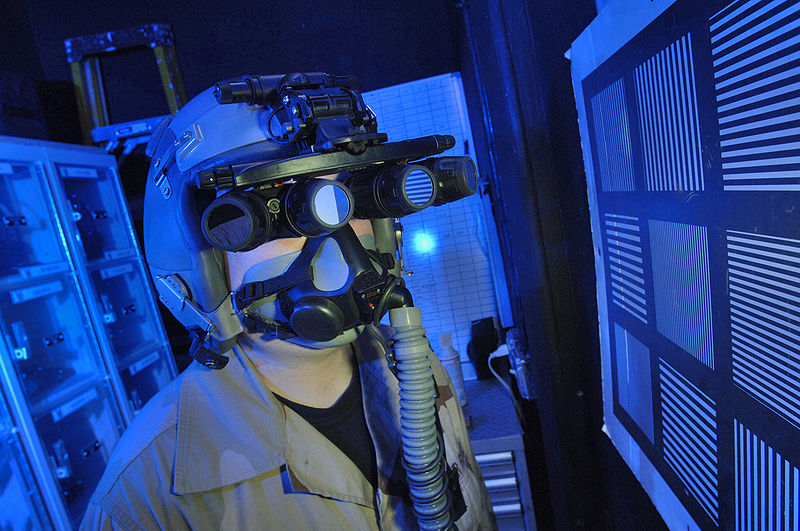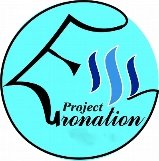Tongue Vision Device — BrainPort: A Technological Wonder That Enables The Blind To See With Their Tongues (Research-based)
Impossible! Isn't it? Well, the word impossibility is antithetical to the field of science. Scientists don't believe in impossibility. Everything is possible in realm of science, a typical scientist would say. Change is one indisputable ingredient of science. That this is like this today is no basis to believe, scientifically, that it would remain so forever. Scientific belief in a phenomenon is only potent for as long as experiments can validate. Otherwise, a new scientific opinion would arise to challenge the status quo.

[Source: wikimedia common. Author: Master Sgt. Lance Cheung. CC BY-SA 3.0 licensed]
So YES! You can actually see with your tongue by using a sensory substitution enabling device called BrainPort, which enables the blind and visually impaired to have experience of vision by sending the light signals received on the nerves on the tongue's surface to the brain. How and why such is possible is the chief essence of this article.

The defeat of agelong belief that "only the eyes can see" using brain neuroplasticity and sensory substitution arguments
Until Paul Back-y-Rita demonstrated his idea of sensory substitutuon via brain plasticity, neuroscientists have wrongly believed that brain is compartmentalized. That is to say, with respect to vision, that visual information emanates from the eyes and are relayed to the visual cortex of the brain through a network of optic nerves. If any part of the system is damaged in the process of this to and from movement of visual impulses, then sight will be impossible. To put it in other words, only the eyes can see.
This agelong misconception was motivated by the work of the early French neurologist Paul Broca, who found lesions in the frontal lobe of a speechless man. And therefore concluded that specific areas of the brain is in charge of performing specific functions. Many studies would later seem to agree with his conclusion.
However, Neuroscientist Paul Bach-y-Rita, a rehabilitation doctor at University of Wisconsin, Madison, and a pioneer in the field of neuroplasticity (i.e the proven idea that adult brain can learn and reorganize itself for optimal performance with training), did not agree with Dr Broca's conclusion. Bach-y-Rita, while alive, devoted much of his professional life to understanding the single revolutionary concept that our senses are interchangeable.

[Source: Pexels CC0 licensed]
Banking on the successes of his works, he opined that brain is an astonishing organ of neuroplasticity — the idea of sensory substitution; if one part of it is damaged, another part can be made to serve the same function via training.
Writing in an abstract on Dr Broca's conclusion, Bach-y-Rita, notes:
One of the factors leading to the virtual neglect of the long-term potential for functional recovery following brain damage was the eclipse of plasticity concepts during the 100 years following Broca's 1861 publication on location of function. However, in the last 30 years evidence has been accumulating that demonstrates the plasticity of the brain and thus recovery potential is a subject of practical as well as theoretical interest... Source
And while alive, Paul Bach-y-Rita, was reported to have said:
"We don't see with our eyes; we see with our brains. The ears, eyes, nose, tongue and skin are just inputs that provide information. When the brain processes this data, we experience the five senses, but where the data comes from may not be so important. Clearly, there are connections to certain parts of the brain, but you can modify that. You can do so much more with a sensory organ than what Mother Nature does with it." Source
Bach-y-Rita argued that the widely held agelong belief that only the eyes can see is grossly false, stating that two different senses can swap functions through sensory substitution via brain neuroplasticity. Braille reading that allows the blind to read by the use of somatosensory system, is a vivid example of sensory substitution in action.
For ages, blind people have substituted for vision through feeling the bumps of Braille text or listening to talking books. If they were actually not having sense of vision, Bach-y-Rita observed, Braille text device would have been useless. Bach-y-Rita would later form a company, Wicab Inc that pioneered the development of the Tongue Display Unit (TDU) — a sort of human machine interface that make use of the tongue as a medium for visual substitution in blind people. TDU is the major component of BrainPort, which itself is the product of Wicab Inc that allows blind people to experience sense of vision through the tongue.
1.jpg)
[The original braille code for the French language, as devised by Louis Braille c.1824. Wikimedia commons. Author: SteveStrummer. CC0 1.0 licensed]
A taste of vision: Paul Bach-y-Rita's experiment (How BrainPort works)
The success of Bach-y-Rita's experiment was what gave rise to the development of BrainPort device (that enables blind people to achieve vision by tongue stimulation) by a team of neuroscientists led by him. The procedure that we will be giving consent to in this section does not only represent Bach-y-Rita's experiment, it is also a representation of how a typical BrainPort works.
Naturally, approximately two million optic nerves are involved in the transmission of visual impulses from the retina to the visual cortex region of the brain. Retina is the part of the eyes where light signals are converted to nerve impulses before being sent to brain for interpretation as images.
With BrainPort, the eyes are bypassed and no visual signals are sent to the retina. Instead, visual information are gathered by a small digital camera that is built on the middle of a pair of sunglasses worn by the test subject.
The visual information collected by the digital camera is then transmitted to a handheld base unit, which is about the size of a cell phone. This base unit has such components as zoom control, light settings and shock intensity levels in addition to a Central Processing Unit (CPU). The CPU helps process the visual information so received into electrical impulses and thus replaces the function of the retina.
The electrical impulses from the CPU component of the base unit are sent to a set of 400 microelectrodes that are arranged in a lollipop-like paddle sitting on the tongue. As these microelectrodes receive electrical signals from the CPU, they stimulate the densely packed nerves at the surface of the tongue, giving the sensation of Pop Rocks candies or champagne bubbles to the test subject or the user.

[Source: pixabay CC0 licensed]
It is these sensations being felt on the tongue that the user's brain learns to interpret, over a period of time, as a kind of visual sensation. Even with a normally sighted person, the brain does not see. It only interprets the electrical signals from the retina and then create a picture that helps us move around and find nearby objects.
"In any case, within 15 minutes of using the device, blind people can begin interpreting spatial information via the BrainPort," says William Seiple, research director at the nonprofit vision healthcare and research organization Lighthouse International.
The electrodes spatially correlate with the pixels so that if the camera detects light fixtures in the middle of a dark hallway, electrical stimulations will occur along the center of the tongue.
"It becomes a task of learning, no different than learning to ride a bike," Arnoldussen says, adding that the "process is similar to how a baby learns to see. Things may be strange at first, but over time they become familiar." Source
Conclusion
Paul Bach-y-Rita's research has shown that indeed there is nothing special about optic nerves (eyes). What was thought as its special function can be taken up by another sense organ (tongue) by compelling the visual cortex region of the brain to interpret it as a visual sensation via training. Indeed, the brain does not care about where the information comes from.
"Do you need visual input to see?" Bach-y-Rita asked. "Hell, no. If you respond to light and you perceive, then it's sight."
Many studies conducted years later to evaluate the veracity of Bach-y-Rita's claims seemed to have agreed with his position that senses can be redirected. For instance, in the late '90s, neurologist Alvaro Pascual-Leone of Harvard University carried brain scans of blind people and normal sighted people while they were made to read Braille with their reading fingers. He found that while the two groups were performing the same task of reading Braille, the visual cortex of the blind people lit up but those of the sighted people remained the same.
One would be right to conclude, therefore, that Bach-y-Rita's research is teaching an entirely different approach to understanding the concept of sight —that sight is not a mere detailed understanding of light and space around us; it is all about a particular feeling. Thanks for reading.
Yours truly,
@eurogee
References for further reading
- Rewiring the brain to create new senses
- Brain plasticity as a basis for recovery of function in humans
- "Seeing" with your tongue — sensory substitution using a simple alternative to the retinal chip
- "Seeing" through the tongue: cross-modal plasticity in the congenital lyrics blind
- Can you see with your tongue?
- Device lets the tongue see
- A taste of vision: device translates from camera to brain, via the tongue
- Tasting the light: Device lets the blind "see" with their tongues
- Device that helps blind people see with their tongues just won FDA approval
Follow @eurogee, the Steemit's Witness Voting Advocate & Host, Show Us Your Witnesses Weekly Contest. Follow @euronation, An International Support Scheme For New And Struggling Steemians
Join us on Telegram and whatsaap through the below links:

Don't Exit Without Voting For Witnesses!
No Witnesses = No Steem Blockchain; If You Truly Love Here, Vote For Witnesses NOW!
Click This Link To Vote Now
Witnesses are equivalent to life and blood of steem blockchain. Without them, the blockchain will seize to function and we will all be stranded here. Click here to read more on why it is important to vote for witnesses


I can make women see God with my tongue..why not see with it now!!?
@eurogee, this discovery is so mindblowing. Knowing that blind people can actually see with this sensor on their tongue is so revolutionary.
However, my question is how long will it take for this technology to reach every common blind man out there in order for them to improve the quality of their lives?
Anyway, I really look forward to the accessibility of this technology to people who really need it.
Thank you so much for taking the time to share this us.
My Sis na money o😂 currently it cost $10000 to have one. And only available in USA for now.
@eurogee
This is goodnews especially for those that are blind, meaning there is hope of seeing again for them. Just Like @evarich say, I pray this device become available to those that needs it.
Thank you @eurogee for this information.
Thanks. It's available if you have your money ready😂
It's getting better everyday with technology
Awesome discovery
Sure. Thanks
Wow just wow... This is beyond good news... This is a great news... Hope every visually impaired person will be having a chance to experience this... Have a great day sir ☺️😘
Yes they will but only those with liquid 10,000
Ohhhh,, lucky for those who have....
It ia amazing the new technology of this world
Wooow I'm stupefied by this technology. But for every blind person to have this opportunity it will really be another difficult task.however its good at least a solution is out.steemit is really a place to be as it increases one's knowledge about every domain of life.thanks for this information. I'm new on steemit and hope to equally contribute through my writing.will be honored you check out my post